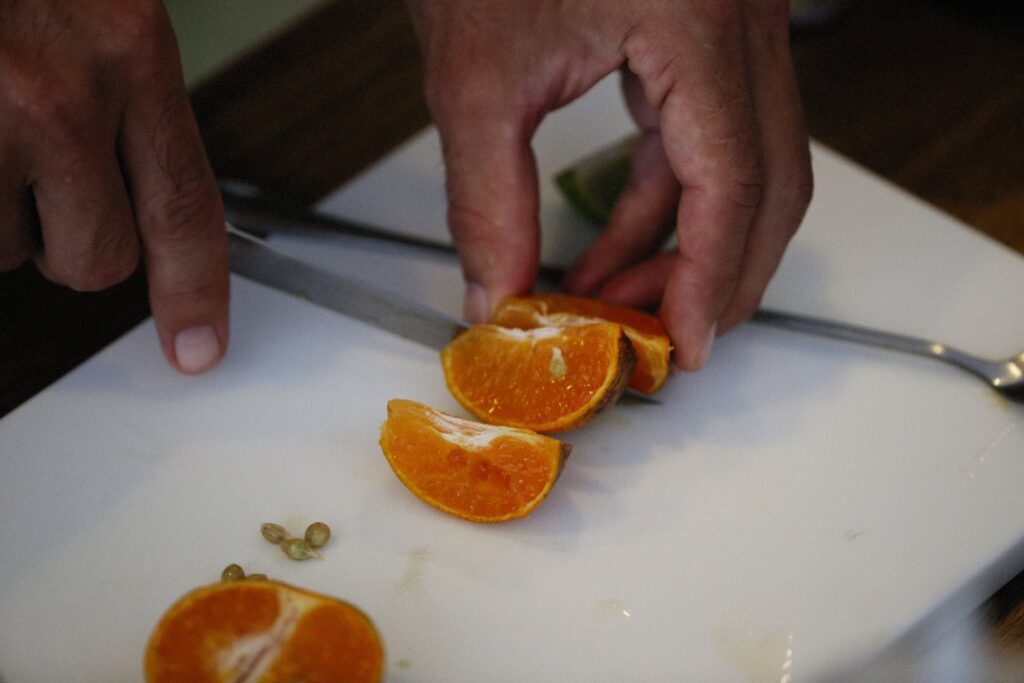Have you ever wondered what satsuma smells like? You’re not alone. In fact, over 80% of people have no idea what this juicy citrus fruit smells like!
If you’re looking for a fun and fruity aroma, then you’re in luck. Satsuma is the perfect citrus to tantalize your senses.
Let’s explore the characteristics of satsuma’s aroma, how to use it in recipes, and tips for selecting quality satsuma.
So, what’s the big deal about satsuma? Let’s find out!
Key Takeaways
- Satsuma has a surprisingly sweet aroma with a hint of citrus.
- The fragrance of satsuma is unique and cannot be replicated.
- The aroma of satsuma is a perfect balance of tartness and sweetness.
- Satsuma’s scent is pleasant and can uplift your mood.
What Does Satsuma Smell Like: The Characteristics of Satsuma’s Aroma
Have you ever smelled a satsuma?
It has a surprisingly sweet aroma with a hint of citrus.
Its natural fragrance is one that can’t be replicated.
Sweetness of Satsuma
You’ll notice a sweet scent emanating from satsumas. It’s a combination of their citrusy notes, aromatic quality, and juicy sweetness.
The combination of these elements creates a unique fragrance that’s both tangy and floral. The delightful aroma of satsuma will tantalize your senses with its sweet, fruity, and tangy flavor.
You’ll be sure to enjoy the unique fragrance and flavor of this delicious fruit. Its sweetness is a perfect balance of tartness and floral notes, making it the perfect addition to many recipes.
Whether you’re looking for a refreshing snack or a delightful dessert, satsuma’s sweetness is sure to please.
Citrusy Aroma
The aroma of a satsuma has a citrusy quality, with a sweet, floral undertone. The juicy notes give it a balmy quality, while the zesty scent adds a crisp flavor.
The tangy taste is unmistakable, but its sweetness is what really stands out. It’s like a fruity explosion of flavor, with just the right amount of zing. Plus, its smell is so pleasant that it could make even the biggest grump smile.
Natural Fragrance
You’ll notice the natural fragrance of a satsuma, with its sweet and floral notes accompanied by a zesty tang. Its invigorating scent will fill the air with its fruity tones and subtle sweetness.
You’ll be delighted by its exotic aroma, leaving you feeling energized and refreshed. The floral notes surrounding the citrusy tang are reminiscent of a summer’s day, and the zesty zing of the satsuma will leave you feeling delightful.
The aroma of the satsuma is truly unique, with its combination of sweet and floral notes that will leave you feeling instantly uplifted. Enjoy the natural fragrance of this delightful citrus fruit!

How to Use Satsuma in Recipes
You can add satsuma to many recipes to enhance their flavor and aroma. Grilling satsuma is an easy way to add a hint of citrusy goodness to any meal. Plus, satsuma sauces, drinks, and desserts are a sweet way to get your daily dose of vitamin C.
Try making a satsuma margarita for an extra-special kick. Or, if you’re feeling adventurous, make a satsuma tart for a citrusy twist on a classic dessert. And don’t forget about satsuma-marinated grilled chicken for a zingy summer treat.
Get creative and have fun with this juicy citrus fruit!
Benefits of Eating Satsuma
Eating satsuma can really amp up your vitamin C intake! With a sweet, citrusy flavor, it’s easy to see why satsumas are beloved as a snack.
But did you know that these little fruits have a multitude of health benefits? Not only are they packed with nutritional value, but they also have a longer shelf life than other citrus fruits. Plus, the storage methods for satsumas are simple and straightforward.
Compared to other citrus fruits, satsuma is milder in taste and just as juicy. So if you’re looking to incorporate more citrus into your diet, satsuma is the way to go!

Tips for Selecting Quality Satsuma
When selecting quality satsumas, there are several key factors to consider. Two important factors to consider are smell and texture. To determine if a satsuma is of good quality, you should give it a good sniff. A fresh, citrusy aroma is a good sign, while a lack of scent or an off smell may indicate a lower quality fruit.
In addition to smell, it’s important to check the texture of the satsuma. The skin should be slightly rough, with no wrinkles or dents. A smooth or damaged skin may indicate a less desirable fruit.
Size and color are also factors to consider. If you prefer larger satsumas, make sure to choose one that is ripe and ready to be eaten. The size may impact the taste and texture of the fruit. Additionally, selecting satsumas that are harvested at the right time can have an impact on the nutritional value of the fruit.
Finally, if you plan on storing your satsumas, it’s important to keep them at room temperature and avoid direct sunlight. This will help to maintain the quality and freshness of the fruit.
What Even is Satsuma
You’ve likely heard of satsuma, but do you know what it is? It’s a type of citrus fruit, a member of the mandarin orange family, and is surprisingly versatile. Here’s a breakdown of what you need to know about satsuma:
- Eating Satsuma:
- Health Benefits: With its high vitamin C content, fiber, and antioxidant-rich flavonoids, satsuma is a great addition to any diet.
- Pairing Flavors: The sweet-tart flavor of satsuma pairs wonderfully with other fruits, vegetables, and herbs.
- Satsuma Nutrition Facts:
- Ripeness Test: To tell if a satsuma is ripe, check to see if its skin is slightly soft and fragrant.
- Harvesting Techniques: Satsumas are usually harvested in the fall, using a combination of hand-picking and mechanical harvesting.
No matter how you eat it, satsuma is a delicious and nutritious fruit. So go ahead and give it a try — you won’t regret it!
Frequently Asked Questions
What Are the Different Varieties of Satsuma?
You’ll love exploring the different varieties of satsuma. Each has its own unique cooking methods, taste notes, scent notes, texture differences, and nutritional benefits. Get ready for a delicious adventure! From sweet to tart, you’ll find a satsuma to make your taste buds dance. And if that’s not enough, you’ll be in aromatic heaven with the tempting scents of these citrusy delights. So, let’s get cooking!
Are There Any Health Risks Associated With Eating Satsuma?
Not to worry! Eating satsuma has its nutritional benefits, but there are no health risks associated. Learn the peeling techniques, storage methods, and flavor combinations to get the most out of your satsuma. Enjoy the health benefits, and don’t forget to have some fun while you’re at it!
Does Satsuma Have a Long Shelf Life?
Yes! Satsumas have an impressive shelf life – up to 3 weeks when stored correctly! To maintain their texture and flavor nuances, keep them at room temperature and away from direct sunlight. For some traditional recipes, you may even find a satsuma can last up to a month! So, grab a few and enjoy the sweet citrusy flavor without fear of them aging too quickly.
Does Satsuma React With Other Ingredients in Recipes?
Hey, you baking aficionado, you! You wanna know if satsuma reacts with other ingredients? Sure does! Depending on the dish, satsuma can provide some serious nutrition, but it also adds a unique aroma to your baking. Store it right and it’ll last a long time. Still not sure? No prob, just substitute it with something else!
Are There Any Alternatives to Satsuma for Similar Flavor Profiles?
If you’re looking for a tasty alternative to satsuma, you’ll be delighted by its citrus blend of freshness, sweetness, and taste variations. Perfect for all kinds of culinary uses, it’s sure to be your new go-to citrus fruit. Bon appétit!
Conclusion
Satsuma is a sweet, tangy, and delicious fruit that can be enjoyed in a variety of ways. Its unique aroma is a combination of sweet and sour, making it an ideal addition to any recipe.
With its tremendous taste and health benefits, satsuma is a sensational snack that’s sure to satisfy. So, savor the scent of satsuma and stay healthy – living life luxuriously with this flavorful fruit!

Experienced writer with 100+ written posts about fragrances and scents
